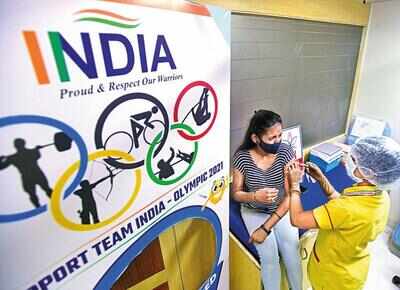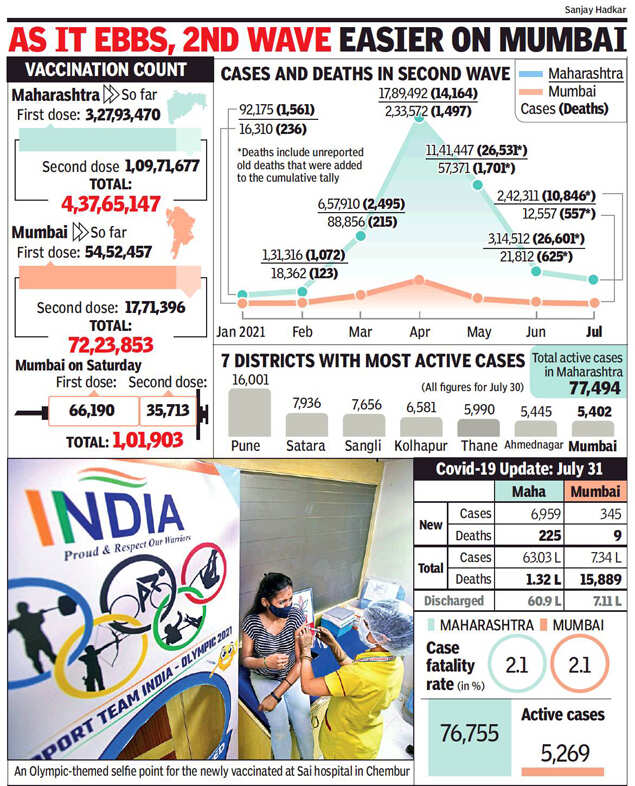- News
- City News
- thane News
- Tale of two tails in Mumbai: 12,557 Covid cases in July against the 16,310 in January
Tale of two tails in Mumbai: 12,557 Covid cases in July against the 16,310 in January

An Olympic-themed selfie point for the newly vaccinated at Sai hospital in Chembur
MUMBAI: So far this year, July appears to have been the best month as far as the Covid-19 pandemic is concerned — and, as the statistics show, more so for Mumbai than Maharashtra.

The July caseload in the state — despite talk of the “thick tail” of the second Covid wave — is almost a third of the 6.57 lakh cases registered in March.
But it is Mumbai, a hot spot during both the Covid-19 waves, that had a low Covid scoreboard in July. The July tally (12,557) is lower than the January tally (16,310), which is now accepted as the period between the two Covid waves. At present, Mumbai’s daily tally and death count make up for about 5% of the state’s daily caseload and fatalities. On Saturday, the city tally of 345 accounted for 4.9% of Maharashtra’s tally of 6,959. Mumbai registered nine deaths, or 4% of the state’s Saturday toll of 225.
In July, there was a significant drop in the number of deaths. In the state, 10,846 deaths were registered as against 26,601 in June. In Mumbai, 438 deaths were counted in July, way higher than the pre-second wave figure of 123 deaths in February. Officials said May and June reported higher number of deaths compared to July due to the data reconciliation exercise that started in mid-May and ended in July. The state’s case fatality rate (CFR) for this month is nearly 4%.
The total caseload of the state rose to 63 lakh on Saturday, of which 7.34 lakh cases were in Mumbai. The Covid-19 fatalities also climbed to 1,32,791 of which 15,889 were in Mumbai. The continuous decline in the daily detections in Mumbai has pushed it down to the seventh spot in terms of the active cases in the state. Smaller districts like Satara, Sangli and Ahmednagar have more active cases than Mumbai.
BMC officials remain wary of saying that the second wave is over. “The predicted third wave is less than a month away. How can we relax enough to say that the second wave is over?” said additional municipal commissioner Suresh Kakani. “Our vigil continues like before,” he added.
Every day, close to 35,000 tests are conducted and wards with the highest cases are closely monitored. “We know that parts of the D ward (Malabar Hill), K West, K East, R South and R Central are still witnessing cases,” said Kakani. The BMC analysis showed 91% of the positive cases live in buildings and steps are being taken accordingly.
A BMC doctor said Covid-appropriate behaviour, especially use of masks, is fast dropping in the city. “At this rate, the festive season later this month could be accompanied by a rise in cases,” he added.
State officials said that while metro cities like Mumbai, Nagpur and Pune, which were driving the Covid graph during the peak, have reported a decline in cases, smaller districts like Satara, Kolhapur, Ahmednagar and Sangli continue to add cases.
With the cases plateauing, there has been a demand for opening up more sectors in the state just like Delhi, which was one of the worst-affected during the second wave.
Minister Aaditya Thackeray said that as per doctors there was another variant at play in Delhi where the cases shot up quickly and came down with the same speed. “For Maharashtra the thick tail has remained for over three months now. We are being painfully slow and cautious in opening up,” said Thackeray while speaking at an online event on Saturday.

The July caseload in the state — despite talk of the “thick tail” of the second Covid wave — is almost a third of the 6.57 lakh cases registered in March.
But it is Mumbai, a hot spot during both the Covid-19 waves, that had a low Covid scoreboard in July. The July tally (12,557) is lower than the January tally (16,310), which is now accepted as the period between the two Covid waves. At present, Mumbai’s daily tally and death count make up for about 5% of the state’s daily caseload and fatalities. On Saturday, the city tally of 345 accounted for 4.9% of Maharashtra’s tally of 6,959. Mumbai registered nine deaths, or 4% of the state’s Saturday toll of 225.
In July, there was a significant drop in the number of deaths. In the state, 10,846 deaths were registered as against 26,601 in June. In Mumbai, 438 deaths were counted in July, way higher than the pre-second wave figure of 123 deaths in February. Officials said May and June reported higher number of deaths compared to July due to the data reconciliation exercise that started in mid-May and ended in July. The state’s case fatality rate (CFR) for this month is nearly 4%.
The total caseload of the state rose to 63 lakh on Saturday, of which 7.34 lakh cases were in Mumbai. The Covid-19 fatalities also climbed to 1,32,791 of which 15,889 were in Mumbai. The continuous decline in the daily detections in Mumbai has pushed it down to the seventh spot in terms of the active cases in the state. Smaller districts like Satara, Sangli and Ahmednagar have more active cases than Mumbai.
BMC officials remain wary of saying that the second wave is over. “The predicted third wave is less than a month away. How can we relax enough to say that the second wave is over?” said additional municipal commissioner Suresh Kakani. “Our vigil continues like before,” he added.
Every day, close to 35,000 tests are conducted and wards with the highest cases are closely monitored. “We know that parts of the D ward (Malabar Hill), K West, K East, R South and R Central are still witnessing cases,” said Kakani. The BMC analysis showed 91% of the positive cases live in buildings and steps are being taken accordingly.
A BMC doctor said Covid-appropriate behaviour, especially use of masks, is fast dropping in the city. “At this rate, the festive season later this month could be accompanied by a rise in cases,” he added.
State officials said that while metro cities like Mumbai, Nagpur and Pune, which were driving the Covid graph during the peak, have reported a decline in cases, smaller districts like Satara, Kolhapur, Ahmednagar and Sangli continue to add cases.
With the cases plateauing, there has been a demand for opening up more sectors in the state just like Delhi, which was one of the worst-affected during the second wave.
Minister Aaditya Thackeray said that as per doctors there was another variant at play in Delhi where the cases shot up quickly and came down with the same speed. “For Maharashtra the thick tail has remained for over three months now. We are being painfully slow and cautious in opening up,” said Thackeray while speaking at an online event on Saturday.
FacebookTwitterLinkedinEMail
Start a Conversation
end of article
Quick Links
Delhi Air PollutionDelhi TemperatureChennai WeatherBangalore TemperatureCovid vaccination centres in DelhiCoronavirus in DelhiRTPCR test in GurgaonHyderabad RainPollution level in BangaloreDelhi SmogDelhi TemperatureNoida AQIGurgaon AQI todayFire in MumbaiMumbai RainsCovid 19 RT PCR Test in NoidaDelhi AQI todaySrinagar encounter

